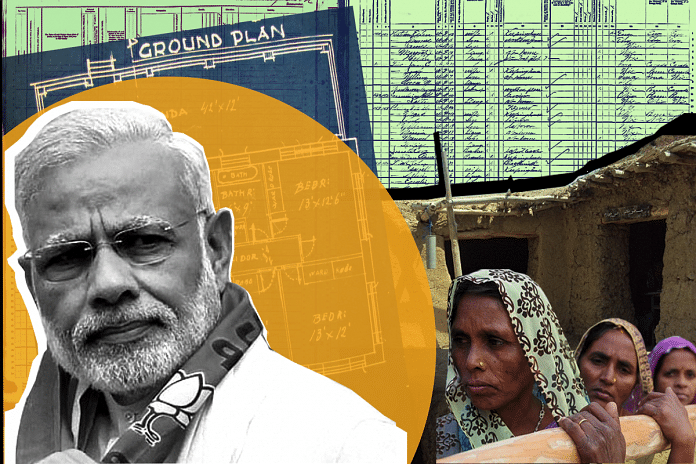Women’s welfare is one of Modi govt’s major election planks yet data shows a drop by half in the number of houses given to women.
New Delhi: Prime Minister Narendra Modi talks about championing women’s causes and claims the focus of his government’s flagship rural housing scheme is to give more women access to housing.
It turns out, however, that the number of houses in rural areas sanctioned in the name of women has seen a sharp dip in the last two years.
It was in 2016 that the Modi government revamped the UPA’s Indira Awas Yojana (IAY) and presented it as the Pradhan Mantri Awaas Yojana (Gramin). The PMAY (G) was introduced on 1 April, 2016, with an aim to provide “housing for all’’ by 2022.
The scheme’s immediate objective is to cover 1 crore households living in
kutcha/dilapidated houses by 2018-19. It has been dear to PM Modi, and was launched by him in November 2016.
Politically, the scheme is of utmost importance to the BJP as the party hopes to fight the assembly polls at the end of the year and Lok Sabha elections next year on a welfare plank.
Modi’s constant mention of the scheme and his emphasis on how this is his government’s baby is an indication that his party is going to use rural housing in a big way when it goes to the electorate.
What the figures say
Government data analysed by ThePrint shows that in 2010-11, an overwhelming 56 per cent of houses under IAY were sanctioned for women, 21 per cent for men and around 12 per cent in joint names. The remaining 11 per cent is with the others category, said a government official, without giving details. (The figures are for all central rural housing schemes but the proportion of others besides IAY and PMAY is minuscule).
The figure for women, the following year, even touched 59 per cent.
Until 2015-16 — the last financial year before IAY was replaced with PMAY(G) — houses sanctioned to women stabilised at around 50 per cent.
Also read: In 2 yrs of overhaul, Modi govt’s rural housing scheme has doubled number of houses built
It’s only in the next year, when the Modi government relaunched the scheme, that a sharp drop can be seen — the figure for women in 2016-17 was at 32.3 per cent.
In 2017-18, the slide continues, with just 27.5 per cent of the total houses sanctioned under PMAY(G) being sanctioned in women’s names, while 36 per cent were in the name of men and the same percentage were under joint names.
In the current financial year, of the total rural houses sanctioned so far, 22 per cent have been made to women, while 36 per cent and 42 per cent have been made to men and under joint names respectively.
So, the percentage of rural houses given to poor women under the scheme has gone down from more than half of the total houses to just about one-fourth now.
Notably, however, it isn’t the houses given to men that have gone up, even though it has been above the one-third mark, but those sanctioned under joint names. From single-digit percentages in some years, to around 25 per cent in 2015-16, the figure jumped to 34 per cent in 2016-17, and has been on the rise since.
Modi, meanwhile, has maintained that one of his government’s key focus areas is women, underscored by campaigns such as Beti Bachao, Beti Padhao and schemes such as Ujjwala that primarily target women.
During his interaction with PMAY(G) beneficiaries through video conferencing in June, the Prime Minister said the aim of the scheme was to ensure “more women, differently-abled sisters and brothers, SC, ST, OBC, and minority communities get access to housing”.
Also read: In election year, Modi and Shah have a new headache — the angry upper caste voter
‘Women still the focus’
The Rural Development Ministry explains this drop, saying most eligible women-headed households have been exhausted, and so the push now is for joint holders.
“In our permanent wait list, women-headed households got priority and that is why their sanctioned numbers were high initially. Most of them got houses, hence the number of houses sanctioned to women subsequently went down,” said a senior ministry official.
“Even now, the instruction from the ministry is to sanction as many houses in the name of women, or in joint name, as we identify beneficiaries through SECC.”
As per the Socio-Economic Caste Census 2011, around 13 per cent of rural households are headed by women and 12 per cent of women-headed households actually own the house.
As a scheme, PMAY (G) has been implemented with full gusto by the nodal Rural Development Ministry, witnessing a sharp spike in the completion of houses under it since it was re-structured in 2016, nearly doubling the output.
The government claims this has been possible because of more targeted beneficiary selection done on the basis of the SECC, as well as continuous, effective monitoring.



